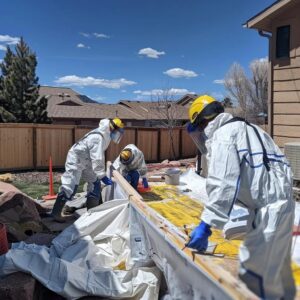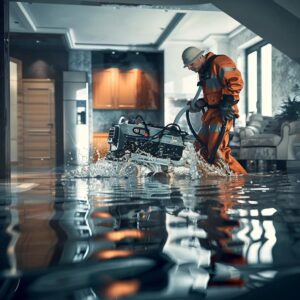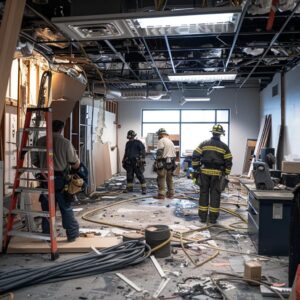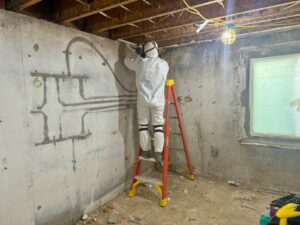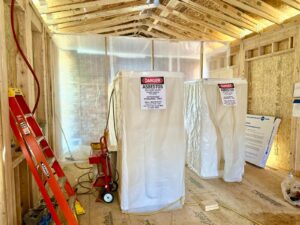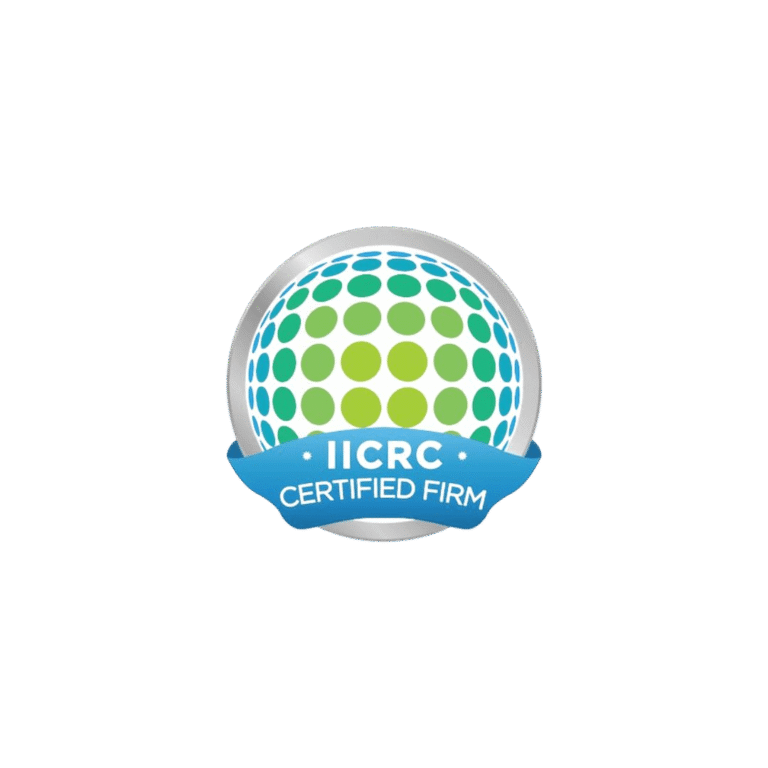QUICK SUMMARY
- KEY FACTS: 14,000 Americans experience water damage emergencies daily. In Colorado, frozen pipes are the #1 cause during winter months, with the state’s unique climate creating specific challenges from ice dams to flash flooding. Average restoration cost in Colorado: $3,826 (range: $1,364-$6,291).
- CRITICAL TIMELINE: Response within 24-48 hours prevents mold growth and reduces costs by up to 50%. Category 1 (clean water) degrades to Category 2 (gray water) within 48 hours if untreated. Colorado’s varied elevation and climate zones affect drying times.
- COST FACTORS IN COLORADO: Water category (clean $3.75-$4.75/sq ft, gray $4.50-$6.50/sq ft, black $7.00-$7.50/sq ft), affected area size, elevation (impacts drying time), winter response fees, and material types. Colorado’s dry climate aids drying but freezing temperatures complicate winter restoration.
- INSURANCE: Homeowners insurance typically covers sudden, accidental damage (burst pipes, appliance failures) but NOT flooding (requires separate flood insurance). Water damage represents 30% of all homeowner insurance claims nationwide, with Colorado claims averaging $8,500.
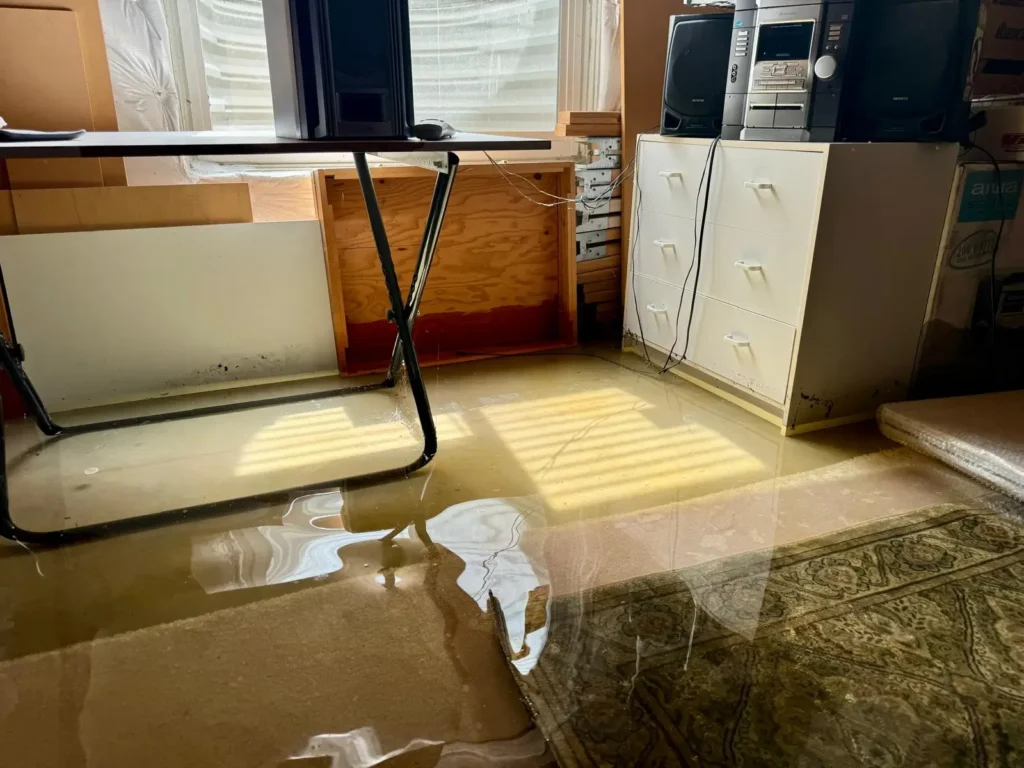
As Colorado’s leading water damage restoration specialists with over 15 years of experience, we’ve seen firsthand how water can wreak havoc on homes across the Front Range. From burst pipe water damage in Colorado winters to flash flooding in summer months, water damage is an unfortunate reality for many Colorado homeowners.
According to IBISWorld (2025), the U.S. restoration industry reached $7.1 billion in 2025, growing at 4.5% annually, with water damage accounting for approximately 40% of all disaster restoration services. Industry data shows that 14,000 Americans experience water damage emergencies every single day. In fact, nearly 40% of real estate losses are due to water damage, highlighting just how common and devastating these incidents can be.
When water intrusion occurs where it doesn’t belong, understanding the restoration process can make the difference between a smooth recovery and a prolonged nightmare. This comprehensive guide will walk you through everything you need to know about professional water damage restoration in Colorado, from initial assessment to complete property recovery.
What is Water Damage Restoration?
Water damage restoration is the professional, IICRC-certified process of returning a property to its pre-damage condition after water intrusion. It’s far more comprehensive than simply drying out wet areas – it’s a systematic approach to recovery that addresses both immediate concerns and prevents long-term issues like structural weakening, electrical hazards, and toxic mold growth.
The restoration process involves several critical phases: emergency response, assessment, water extraction, drying, dehumidification, cleaning, sanitizing, and finally, repairing or rebuilding damaged structures. Each phase requires specialized knowledge, professional-grade equipment, and technical expertise that our IICRC-certified technicians bring to every project across Colorado.
According to Mordor Intelligence (2025), the global disaster restoration services market is valued at $42.93 billion and growing at 5.28% annually, driven by increasing climate events and infrastructure aging. Professional IICRC-certified restoration addresses complete moisture detection using thermal imaging cameras (detect hidden water up to 3/4 inch deep), thorough structural drying following specific goals (15% or less moisture for wood, 5% or less for concrete), mold prevention through EPA-approved antimicrobial treatments, insurance documentation with detailed assessments (average claim: $8,500), and certified expertise following IICRC S500 Standard protocols.
While DIY water cleanup might seem tempting for minor incidents, without proper equipment (commercial dehumidifiers removing 150+ pints/day, air movers generating 2,000+ CFM airflow, thermal imaging cameras costing $3,000-$15,000) and training, hidden moisture can lead to serious problems weeks or months later. Professional water damage restoration ensures thorough remediation that addresses both visible damage and the potentially serious hidden effects of water intrusion.
Don't Risk Hidden Water Damage
FREE Professional Assessment • No Obligation
Our IICRC-certified technicians use thermal imaging to detect hidden moisture you can’t see. • Average Response: 60 Minutes
Common Causes of Water Damage in Colorado Homes
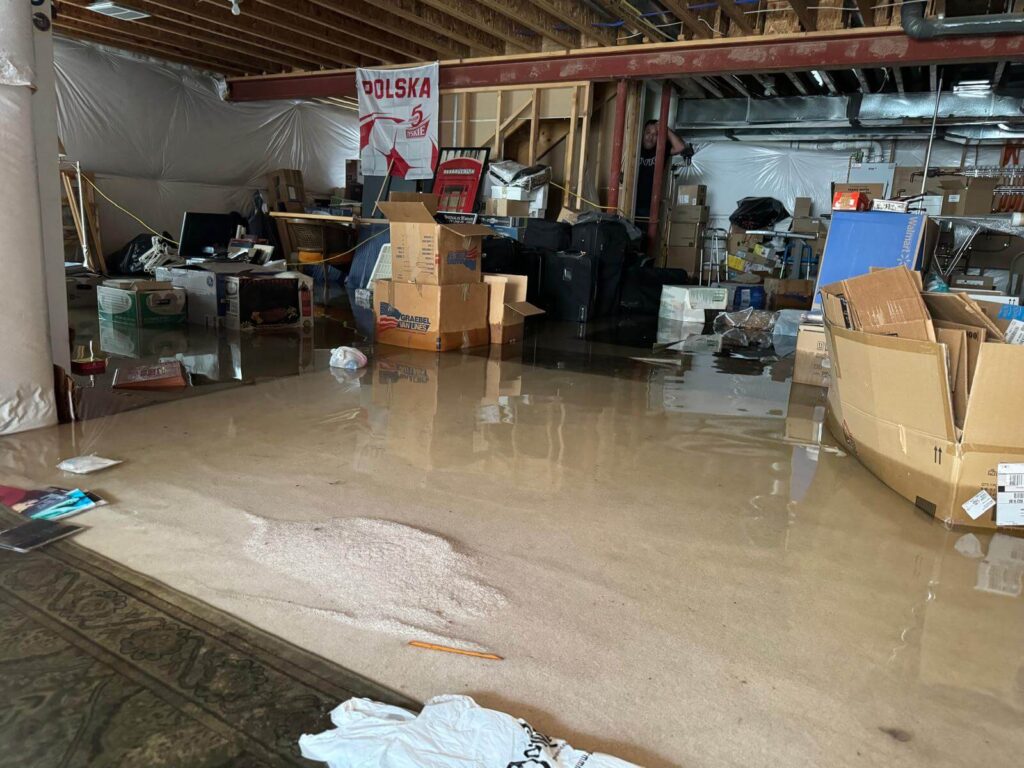
Colorado’s unique climate presents specific water damage challenges that differ from other regions. According to insurance claims data, the most common water damage sources nationally are plumbing failures (45%), weather-related incidents (30%), and appliance malfunctions (25%). In Colorado, our most frequently encountered causes include:
Frozen and burst pipes:
During Colorado’s freezing winters, pipes that aren’t properly insulated can rupture when water expands as it freezes, creating over 2,000 PSI of pressure inside pipes. This pressure causes pipes to burst, typically when temperatures drop below 20°F for extended periods—common in Colorado from November through March. A single 1/8-inch crack can release over 250 gallons of water per day, causing catastrophic damage to multiple rooms within hours.
Ice dams and roof leaks:
Heavy snowfall followed by daytime warming creates ice dams that force water under shingles. This is particularly common along the Front Range where temperature fluctuations are frequent.
Appliance malfunctions:
Washing machines, dishwashers, and water heaters account for many indoor flooding events, regardless of climate.
Bathroom and kitchen overflows:
Clogged drains leading to overflowing fixtures are common issues in homes of all ages.
Sewer backups:
Often caused by line blockages or heavy precipitation events, requiring specialized Category 3 black water remediation.
Flash flooding:
Colorado’s mountainous terrain makes certain areas prone to rapid runoff during heavy rainfall. According to First Street Foundation, 23.7 million U.S. properties are at risk of flooding, with 99% of U.S. counties affected by flooding events between 1996-2019.
Snowmelt issues:
Spring thawing can direct significant water volume toward homes with improper drainage, a particular concern in Colorado’s variable spring weather.
Understanding these causes helps homeowners take preventative measures specific to Colorado’s climate conditions, potentially saving thousands in restoration costs. With over 1 trillion gallons of water leaking from U.S. homes annually, proper maintenance and winterization are critical.
Categories of Water Damage
Professional restoration experts classify water damage into three distinct categories based on contamination levels. This classification system, established by the Institute of Inspection Cleaning and Restoration Certification (IICRC), determines the appropriate restoration approach. Understanding these categories is critical because water damage represents 30% of all homeowner insurance claims, making proper classification essential for accurate restoration and insurance processing.
Category | Description | Common Sources | Health Risk | Restoration Approach | Response Time |
Category 1 Clean Water | Water from sanitary source, no substantial health risk | • Broken supply lines • Sink overflows • Melting snow/rain • Appliance breaks | Minimal initial risk (degrades to Cat. 2 within 24-48 hours) | Standard drying, minimal PPE, most materials salvageable | Within 24-48 hours |
Category 2 Gray Water | Significant contamination, may cause discomfort or sickness | • Washing machine overflow • Dishwasher leaks • Toilet (urine only) • Sump pump failures | Moderate risk, can cause discomfort/sickness if contacted | Enhanced PPE, antimicrobial treatments, some porous materials removed | Within 24 hours (degrades to Cat. 3 in 24-48 hrs) |
Category 3 Black Water | Grossly contaminated, contains harmful agents | • Sewage backups • Toilet with feces • River/stream flooding • Standing water with growth | Severe risk, can cause serious illness or infection | Full PPE, strict containment, extensive material removal, advanced sanitization | Immediate professional intervention required |
While Category 1 water damage is initially “clean,” it can quickly degrade to Category 2 if left untreated for over 24 hours, as bacteria begin to develop in standing water. Similarly, Category 2 water can degrade to Category 3 within 48 hours. This highlights the critical importance of rapid professional response to any water intrusion event. In Colorado’s dry climate, degradation may occur slightly slower, but immediate response is still essential.
Every Hour Counts - Water Categories Degrade Fast
24/7 Emergency Response • We Answer Immediately
Category 1 becomes Category 2 in 24-48 hours, tripling your restoration costs
Classes of Water Damage
In addition to categories, water damage is classified by the extent of water absorption and expected evaporation rates. These classes help determine the equipment needed and likely duration of the drying process. Colorado’s elevation and dry climate can affect evaporation rates, though professional equipment and monitoring remain essential.
Class 1: Minimal water absorption with limited moisture in materials (small affected area, affects less than 5% of room).Average restoration cost: $450-$2,000
Class 2: Significant water absorption in structural materials, typically affecting walls up to 24 inches. Carpet and pad affected, moisture wicked up walls 12-24 inches.Average restoration cost: $1,500-$4,000
Class 3: Maximum water absorption affecting walls, ceilings, insulation, and subflooring. Water from overhead affecting walls, ceilings, insulation, carpet, cushion, and subflooring requiring specialty drying.Average restoration cost: $4,000-$10,000
Class 4: Deep saturation into low-porosity materials like hardwood, concrete, plaster, stone, or brick requiring specialized drying techniques including injectidry systems and low-grain refrigerant dehumidifiers. Average restoration cost: $10,000-$20,000+
Each class requires specific equipment configurations and monitoring protocols that our IICRC-certified technicians are trained to implement, ensuring optimal recovery results.
The Water Damage Restoration Process
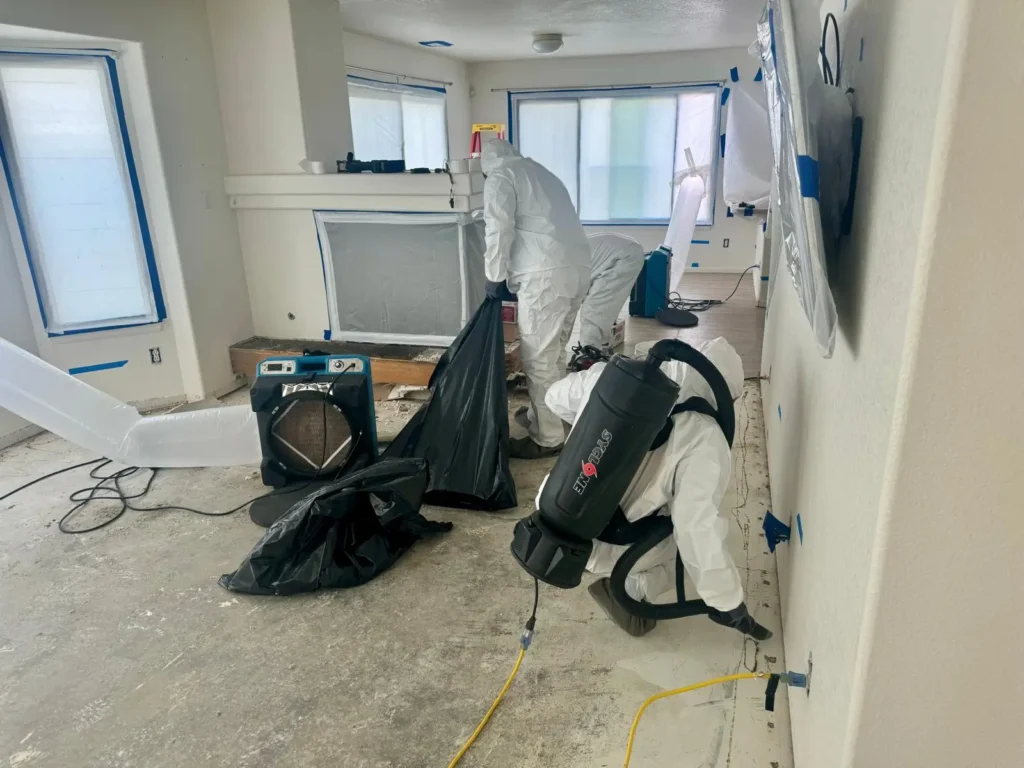
Professional restoration follows the IICRC S500 Standard, the industry’s definitive guide for water damage restoration. According to industry data, 52% of restoration firms reported increased profitability in 2022, indicating strong demand and effective service delivery. The process typically takes 3-7 days for complete drying, followed by reconstruction as needed.
1. Emergency Contact & Assessment
Our Colorado-based emergency response team is available 24/7/365. When you call, we’ll gather critical information about your situation and dispatch the nearest technicians immediately. We prioritize reaching Front Range properties within 60 minutes of your call. The restoration industry includes over 35,000 certified companies nationwide, but local response time is critical.
While waiting for our team to arrive, we’ll guide you through immediate safety steps: (1) Shut off water source at main valve (typically near water meter), (2) Turn off electricity to affected areas at breaker box, (3) Document damage with photos and videos, (4) Remove valuables when safe to do so, (5) Use mops or wet-dry vacuums if safe. Every hour of standing water increases absorption and damage severity.
2. Inspection and Damage Assessment
Upon arrival, our certified technicians perform a thorough inspection using advanced moisture detection equipment. Complete property assessment takes 1-2 hours and uses:
- Thermal imaging cameras that detect temperature differentials indicating moisture (wet areas appear cooler) and can ‘see’ through walls to identify moisture patterns
- Moisture meters that measure moisture content on a 0-100% scale, penetrating up to 3/4 inch deep in materials
- Thermo-hygrometers that measure relative humidity and temperature, critical for calculating drying rates and equipment placement
This assessment: (1) Identifies the water source and stops it if not already addressed, (2) Determines the water category and contamination level, (3) Assesses the class of water damage and affected materials, (4) Creates a comprehensive restoration plan, (5) Documents conditions for insurance purposes with detailed photos and moisture readings. This systematic approach ensures nothing is overlooked in the restoration process.
3. Water Extraction
Removing standing water quickly is crucial to limiting damage. Immediate removal occurs within 2-8 hours depending on water volume. Our technicians deploy:
- Truck-mounted extraction units (remove 99% of standing water) for major flooding
- Submersible pumps (up to 3,000 GPH capacity) for deep water
- Portable extractors for confined spaces
- Specialized floor mats for hardwood floor water removal
One hour of extraction removes more water than a full day of dehumidification, making this step critical to reducing overall restoration time and preventing secondary damage.
4. Drying and Dehumidification
After water extraction, our technicians strategically place industrial-grade equipment to create optimal drying conditions. This phase requires continuous 24/7 operation for 3-7 days with daily monitoring. We use a scientific approach with:
- Commercial-grade air movers creating airflow of 2,000+ CFM (cubic feet per minute)
- LGR (Low Grain Refrigerant) dehumidifiers removing up to 150 pints per day
- Moisture mapping to track affected areas and verify progress
- Daily monitoring and moisture level documentation with specific drying goals: 15% or less moisture content for wood materials, 5% or less for concrete
- Strategic equipment adjustment based on readings
- Temperature control to optimize evaporation rates
This phase typically lasts 2-5 days depending on the extent of water saturation, materials affected, and environmental conditions unique to Colorado’s varied climate zones. Colorado’s lower humidity can aid natural drying, but professional equipment ensures thorough moisture removal to prevent mold growth.
5. Cleaning and Sanitizing
Once drying goals are met, our team cleans and sanitizes all affected areas over 1-3 days concurrent with final drying stages. This process includes:
- EPA-registered antimicrobial treatments to prevent mold growth
- HEPA air filtration removing 99.97% of particles 0.3 microns or larger
- Odor removal using hydroxyl generators or ozone treatment
- Specialized cleaning for different materials (wood, fabric, electronics)
- Content cleaning and restoration of affected belongings with pack-out services when needed
We use eco-friendly products whenever possible, ensuring your Colorado home is not only dry but healthy for reoccupation.
6. Restoration and Repairs
The final phase returns your property to pre-damage or better condition over 1-4 weeks depending on extent. Depending on the extent of damage, this may include:
- Minor repairs such as drywall replacement (Type X for fire-rated areas) and painting
- Flooring installation (carpet, hardwood, tile) meeting current building codes
- Insulation installation with proper R-value per Colorado building code requirements
- Structural repairs to damaged framing or foundation elements
- Full-scale reconstruction of severely damaged areas
As a full-service restoration company, we handle everything from start to finish, eliminating the need to coordinate between multiple contractors.
From Emergency to Complete Restoration - One Company
Schedule Your FREE Damage Assessment
IICRC-certified • Full insurance documentation • Complete restoration services
The Cost of Water Damage Restoration in Colorado
According to recent 2025 data from Angi, water damage restoration in Colorado costs average around $3,826 (national average: $3,841), with most projects in Colorado falling between $1,364 and $6,291 depending on the extent of damage. When broken down by square footage, the national average cost ranges from $3 to $7.50 per square foot, with Colorado falling within this range based on the category of water damage:
Water Category | Cost Per Square Foot in Colorado |
Category 1 (Clean Water) | $3.75 – $4.75 |
Category 2 (Gray Water) | $4.50 – $6.50 |
Category 3 (Black Water) | $7.00 – $7.50 |
Several factors influence these costs in Colorado specifically:
- Water category: Clean water restoration costs significantly less than black water remediation due to contamination protocols
- Damage class: Higher classes (Class 3 and 4) require more extensive equipment and longer drying times
- Affected area size: Larger areas naturally cost more to restore
- Elevation and climate: Colorado’s varied elevation affects drying times. Higher elevations with lower humidity may dry faster, but require monitoring for proper moisture removal
- Materials damaged: Hardwood, cabinetry, and specialty materials increase costs
- Additional services needed: Mold remediation (averaging $2,225 nationally, following IICRC S520 Standard) or structural repairs add costs
- Response time: Emergency after-hours service may incur additional fees, but immediate response can reduce overall costs by 50%
- Winter conditions: Frozen pipes and winter weather may increase response complexity
- Geographic location: Different areas of Colorado (Denver metro vs. mountain communities) have varying labor and material costs
As the Institute of Inspection Cleaning and Restoration Certification (IICRC) notes: “The cost of water damage restoration should never be estimated without a thorough on-site inspection. What appears to be minor damage can often conceal significant issues that dramatically affect the scope and cost of restoration.”
Get an Accurate Assessment for Your Colorado Property
No two water damage scenarios are identical, making online estimates only general guidelines at best. Several critical factors that can only be evaluated through on-site inspection influence the final restoration costs:
Hidden Damage: Water often migrates to unseen areas behind walls, under floors, and above ceilings—particularly common in Colorado homes with finished basements
Material Saturation: Different building materials absorb and respond to water differently at different elevations
Contamination Spread: The actual category of water damage may change as it contacts different surfaces
Potential Secondary Damage: Risk factors for mold development (even in Colorado’s dry climate) or structural issues
Pre-existing Conditions: Prior water damage or maintenance issues that complicate restoration
Professional water damage assessments include moisture mapping with specialized equipment (thermal imaging, moisture meters), testing for microbial contamination, proper documentation for insurance purposes (Colorado claims average $8,500), identification of salvageable vs. replacement items, and comprehensive restoration plans addressing immediate concerns and long-term prevention. Most reputable Colorado restoration companies offer complimentary damage assessments.
Dangers of Delayed Water Damage Restoration
Acting quickly after water damage is crucial. According to IICRC S500 Standards, the first 24 hours determine whether you face minor repairs or major reconstruction. Within 24-48 hours of water exposure:
- Within minutes: Water spreads throughout property, saturating everything in its path
- Within 24 hours: Drywall begins swelling and breaking down, metal surfaces tarnish, furniture swells and cracks, dyes and inks from materials bleed, Category 1 water begins degrading to Category 2
- Within 48 hours: Mold and mildew can begin growing on damp materials (even in Colorado’s dry climate), wood flooring can warp and buckle, doors and windows swell and won’t operate, metal corrodes, Category 2 water degrades to Category 3
- Within 1 week: Structural timbers can begin absorbing water leading to serious structural weakening, biohazard contamination increases dramatically, electrical systems may become compromised
- Beyond 1 week: Restoration costs double or triple, extensive reconstruction becomes necessary, mold remediation becomes a separate required service.
Each day that passes without proper restoration dramatically increases both the extent of damage and the associated restoration costs. What might start as a $2,000 repair can quickly escalate to $10,000+ if secondary damage occurs. Research shows immediate response can reduce restoration costs by 50% or more compared to delayed action.
⚠️ WAITING COSTS YOU THOUSANDS - ACT NOW ⚠️
Every Hour Increases Damage & Costs by 50%+
24/7/365 EMERGENCY SERVICE • We’re Available RIGHT NOW
Preventing Water Damage in Colorado Homes
Proactive measures specific to Colorado’s unique climate can help prevent water damage:
- Winterize pipes: Insulate exposed piping, especially in crawlspaces and exterior walls. Pipes should be insulated in unheated areas and consider heat tape for extra protection during Colorado’s harsh winters.
- Maintain proper drainage: Ensure downspouts direct water at least 10 feet from your foundation. This is critical given Colorado’s heavy spring snowmelt and summer thunderstorms.
- Install water detection devices: Smart monitors can alert you to leaks before major damage occurs. These are particularly valuable for vacation properties in Colorado’s mountain communities.
- Regular roof inspections: Particularly important after hailstorms, which are common in Colorado, especially along the Front Range corridor.
- Check seals and caulking: Prevent water intrusion around windows, doors, and bath fixtures. Colorado’s extreme temperature fluctuations can cause seals to fail faster than in moderate climates.
- Maintain adequate heating: Keep your home at least 55°F during cold snaps to prevent pipe freezing, even when away. This is critical for Colorado homes, especially in mountain areas.
- Monitor weather forecasts: During Colorado’s unpredictable weather patterns, be prepared for rapid temperature changes and adjust home protection accordingly.
An ounce of prevention is worth a pound of restoration when it comes to water damage, particularly in Colorado where winter pipe bursts are so common.
Value of Professional Water Damage Restoration
Water damage restoration requires specialized knowledge, equipment, and techniques to ensure effective recovery. When water intrusion affects a Colorado property, professional restoration offers several critical advantages:
Scientific Approach: Following established IICRC S500 protocols for effective moisture removal with verified results
Health Protection: Proper remediation of contaminated water prevents health hazards from Category 2 and 3 water
Prevention of Secondary Damage: Thorough moisture removal prevents mold (which can grow within 24-48 hours) and structural issues
Insurance Compliance: Professional documentation facilitates smoother claims processing for the average $8,500 claim
Specialized Equipment: Professional-grade thermal imaging cameras ($3,000-$15,000), commercial dehumidifiers (150+ pints/day), and air movers (2,000+ CFM) ensure complete moisture removal
Colorado Expertise: Understanding how elevation, climate zones, and seasonal weather patterns affect restoration timelines and techniques
The restoration process—from initial assessment through structural repairs—follows industry standards that evolve with technological advancements. With proper professional intervention, most water-damaged properties can be successfully restored, protecting both the structure and its occupants.
Frequently Asked Questions About Water Damage Restoration in Colorado
These questions represent the most common queries from Colorado homeowners and property managers experiencing water damage emergencies:
How long does water damage restoration take in Colorado?
Does homeowners insurance cover water damage restoration in Colorado?
How quickly should I respond to water damage in my Colorado home?
What causes frozen pipes to burst in Colorado homes?
Will water damage lead to mold growth in Colorado's dry climate?
Still Have Questions? We Have Answers.
Speak with a Certified Restoration Expert – No Pressure
Get honest advice about your specific situation • FREE consultation
Take Immediate Action!
Whether facing a burst pipe, basement flooding, ice dam leak, ceiling leak, or sewage backup, response within 24-48 hours prevents mold growth and reduces costs by up to 50%. The average Colorado restoration cost of $3,826 is significantly lower than the $8,500 average insurance claim, but only when addressed promptly.
Don’t wait—contact a certified restoration professional at the first sign of water damage to protect your Colorado property, health, and investment. Our Front Range response teams are available 24/7/365 with average response times under 60 minutes.
🚨 EMERGENCY WATER DAMAGE IN COLORADO? 🚨
CALL NOW – AVAILABLE 24/7/365
✓ IICRC-Certified Technicians ✓ 15+ Years Experience ✓ Average 60-Minute Response Time ✓ Front Range Coverage ✓ FREE Assessment ✓ Complete Restoration Services ✓ Licensed & Insured

